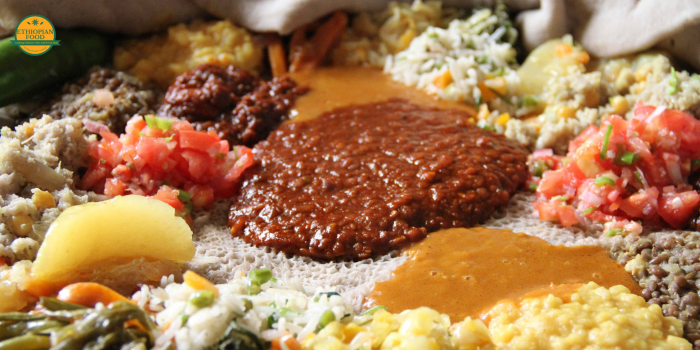Is Ethiopian Food Healthy and its health Benefits?

Ethiopian food is considered generally healthy and offer some nutritional benefits. Like any cuisine, it depends on the specific dishes and ingredients consumed. Here are some points about the health aspects of Ethiopian Food:
1. Plant-based options: Ethiopian cuisine has a strong tradition of plant-based dishes, featuring lentils, chickpeas, vegetables, and greens. These ingredients are rich in fiber, protein, and various vitamins and minerals.
2. Use of whole grains: The staple injera bread is made from teff. An ancient whole grain that is high in fiber, protein, and essential nutrients like iron, calcium, and zinc.
3. Spices and herbs: Many Ethiopian dishes are flavored with spices like berbere, which contains antioxidant-rich chili peppers, garlic, ginger, and other herbs that may offer health benefits.
4. Moderate meat consumption: While meat dishes are present, they are often not the main focus of the meal, with vegetable and lentil stews being more prominent.
5. Clarified butter (niter kibbeh): While this spiced butter adds flavor, it is generally used in moderation, and many dishes can be prepared without it.
6. Fresh ingredients: Ethiopian cuisine emphasizes the use of fresh, whole ingredients, avoiding heavily processed or refined foods.
Some aspects of Ethiopian cuisine may not be as healthy
1. High in carbohydrates: The injera bread and stews can be carbohydrate-heavy, which may be a concern for those watching their carb intake.
2. Use of butter and oils: While not excessive, some dishes do incorporate butter or oils, which can add saturated fat and calories.
3. Spice and salt levels: Certain dishes, like doro wat, can be quite spicy and salty, which may be problematic for those with certain dietary restrictions.
Overall, Ethiopian cuisine can be a part of a healthy and balanced diet, especially when emphasizing the plant-based options, whole grains, and moderate portions. As with any cuisine, moderation and choosing healthier preparation methods can help maximize the nutritional benefits while minimizing potential drawbacks.
What is Injera?
Injera is a spongy, slightly sour flatbread that is a staple in Ethiopian cuisine. Here are some key things to know about injera:
• Made from teff flour – Injera is made from teff, an ancient tiny grain that is nutrient-rich and gluten-free. Teff flour gives injera its distinctive spongy texture.
• Fermentation – The injera batter is allowed to ferment for several days before cooking. Which gives it a slightly sour, sourdough-like taste.
• Cooking method – Injera is cooked on a special clay griddle called a mitad or mogogo. The batter is poured onto the hot surface and cooked into large, round, flat pancake-like bread.
• Appearance – Injera has a porous, bubbly appearance with a spongy, soft texture when cooked properly. It can range in color from tan to reddish-brown.
• Utensil and plate – Injera serves a dual purpose – it is both the “utensil” used to scoop up stews and sauces, as well as the “plate” on which dishes are served.
• Tearing and using – Injera is torn into pieces. And used to pick up tasty morsels from shared dishes in a traditional Ethiopian meal.
• Nutrition – Being made from teff, injera is a good source of fiber, protein, iron and calcium.
Injera is considered the centerpiece of every Ethiopian meal. Its unique texture and flavor perfectly complements the rich stews and sauces it soaks up. Mastering the art of making injera is considered essential in Ethiopian cuisine.
5 different types of popular Ethiopian dishes
1. Doro Wat – This is arguably the national dish of Ethiopia. It consists of chicken stew simmered in a rich berbere (spice blend) sauce, often with hard-boiled eggs and niter kibbeh (spiced clarified butter).
2. Shiro Wat – A popular vegan stew made from ground chickpeas or roasted chickpea flour, seasoned with berbere, garlic, ginger, and other spices. It has a thick, stew-like consistency.
3. Tibs – These are sautéed or pan-fried dishes featuring chunks of meat (usually beef, lamb or chicken). Along with vegetables like onions, tomatoes and jalapeños. Awaze (chili paste) and niter kibbeh add flavor.
4. Kitfo – A dish of finely chopped or minced raw beef mixed with niter kibbeh and spices like mitmita (chili powder blend) and cardamom. Often served with ayib (fresh cheese).
5. Gomen – A Ethiopian Food Healthy side dish of boiled and simmered collard greens or kale, flavored with garlic, ginger, spices and sometimes potatoes or carrots are added.
These represent just a sampling of the diverse array of dishes in Ethiopian cuisine, which features unique spice blends, slow-cooked stews, meat dishes, and plenty of plant-based options showcasing lentils, vegetables and greens.









